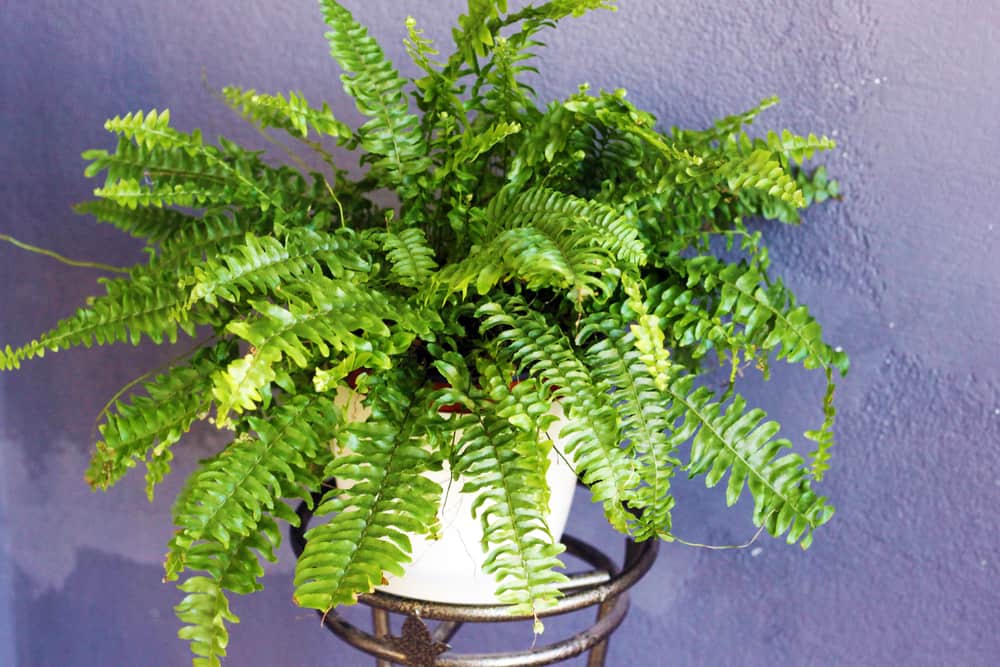HousePlantJoy is supported by our audience. When you purchase through one of our links, we may earn a small affiliate commission. As an Amazon Associate I earn from qualifying purchases. Your cost is not affected.
==================
Are you ready to bring a sprinkle of green into your indoor space? Let me tell you about the Mahogany Fern houseplant. These plants don their vibrant green leaves with such grace and ask very little of you in return. They’re like that best friend who’s always fun and never high-maintenance!
Guess where these green friends come from? Tropical places. Warm and humid spots. So, they really enjoy the indoor life, where it’s cozy and warm.
One thing that makes the Mahogany fern special is its reddish-brown stems. They are like tree trunks supporting a lush, green canopy. It’s like having a tiny forest in your living room! And do you know what else these ferns can do? They purify the air! So, they’re not just pretty, but useful too.
Photo by David J. Stang, CC BY-SA 4.0 <https://creativecommons.org/licenses/by-sa/4.0>, via Wikimedia Commons
Now, here’s the cool part. If you give your Mahogany fern just the right amount of love and care, it can grow. I mean, grow – up to 5 feet tall! It can be the centerpiece of your room, drawing everyone’s eyes with its greenery.
Are you new to caring for plants indoors? Or maybe you’re looking for a plant that won’t give you a hard time? Either way, the Mahogany fern is a superb choice. Easy to look after and gorgeous to look at, it’s a hit with people who love having plants in their homes. So, you’re hoping to make your living room feel like a tropical forest or want to cheer up your workspace? Give the Mahogany fern a thought. Enjoy reading!
What is a Mahogany Fern Houseplant?
Ever heard of the Mahogany Fern? Its other name is Didymochlaena truncatula, but let’s stick with the first one. It’s much easier to say! This lovely plant is part of the big fern family. It originally came from Central and South America. Plant fans like you and me love it because it looks unique and very pretty.
Here’s what’s neat about the Mahogany Fern houseplant. It starts out with a dark brown or bronze color on its leaves, called fronds. Then, as it grows, it changes into a vibrant green! These fronds are thin, and long, and have a delicate look, making the plant seem elegant and dainty. Even though it’s small – only 2 feet tall and 1.5 feet wide at most – it’s perfect for tiny spots or as a plant hanging from the ceiling.
Here’s another reason why you’d love Mahogany Fern: it’s harmless to your pets and kids. So, it’s a safe addition to any home. Looking after this fern is as easy as pie, and it can grow in different conditions. That’s why both new plant parents and the ones who’ve been around the block a few times like it.
Did I mention that Mahogany Ferns can also clean your air? That’s right! They can take away harmful stuff like formaldehyde, benzene, and xylene. So, if you have a room where the air doesn’t move around much, this plant could be your little helper.
Origin of the Mahogany Fern Houseplant
This cool plant hails from tropical places. These include the Caribbean, Central, and South America, and even parts of Africa. It’s a well-liked houseplant. It’s because of its unusual reddish-brown leaves that change into a lush green color as they grow.
-
Native Habitat
The Mahogany fern loves hanging out in shady, damp spots. These include rainforests, riverbanks, and wetlands in their native places. It’s happiest in a place that’s humid and warm. These temperatures are between 60°F and 80°F. It likes soil that drains well and is packed with things from nature. And yes, this fern enjoys a good drink of water regularly to keep its soil nice and damp.
-
Historical Uses
Here’s a cool fact: the Mahogany fern has a long history. People used it in the olden days for both medicine and decoration. Indigenous folks turned to this fern to help with health troubles. These include fever, cough, and breathing issues. They also used it as a natural dye to color clothes.
Nowadays, the Mahogany fern is a favorite plant to keep indoors. This is due to its special leaves and easy-going nature. It’s often seen adding a splash of green in homes, offices, and public spaces.
Physical Characteristics
This houseplant is a beauty that’s sure to stand out. The way it’s shaped and how it grows make it unique.
-
Leafy Details
The leaves of the Mahogany Fern are special. Unlike other ferns, its leaves have two rows of little leaflets. The ones on the top are a bit bigger than the ones on the bottom. These leaflets are shaped like an oblong, sort of like a rounded rectangle, and end with a pointy tip. When they first pop out, they’re a reddish-brown color. As they get older, they turn into a deep green.
-
Growing Up and Out
Mahogany Fern is a plant that likes to keep things compact. It’s perfect if you don’t have much space since it only grows up to 3 feet tall and wide when it’s fully grown. Best of all, this plant is easy to look after and can even grow well with not much light. So, it’s great for indoor places that don’t get a lot of sunlight.
Ideal Growing Conditions
Mahogany Ferns are an excellent choice for indoor plant enthusiasts. They are low-maintenance plants that can thrive in a variety of conditions. So you want to ensure that your Mahogany Fern grows healthy and lush? Then it is essential to provide it with the ideal growing conditions.
Photo by David J. Stang, CC BY-SA 4.0 <https://creativecommons.org/licenses/by-sa/4.0>, via Wikimedia Commons
-
Light Requirements
Mahogany Ferns prefer indirect light, making them perfect for indoor spaces. They can tolerate low-light conditions. But it’s best to place them in a bright, indirect light area to promote healthy growth. Direct sunlight can cause the fronds to burn, so avoid placing them in direct sunlight.
-
Watering Needs
Mahogany Ferns require consistent moisture to thrive. It’s best to keep the soil moist but not waterlogged. Overwatering results root rot, which can be detrimental to the plant’s health. Water the plant when the top inch of soil is dry. It’s best to use room-temperature water to avoid shocking the plant’s roots.
-
Temperature and Humidity Preferences
Mahogany Ferns are tropical plants that prefer warm and humid conditions. They thrive in temperatures between 60°F to 75°F. It’s essential to keep the humidity levels high. This is between 50 to 80 percent. You can increase the humidity levels by putting a bowl of water near the plant or using a humidifier.
Mahogany Ferns are low-maintenance plants that can thrive in a variety of conditions. They prefer bright, indirect light, consistent moisture, warm temperatures, and high humidity levels. By providing your Mahogany Fern with the ideal growing conditions, you can enjoy a healthy and lush plant that will add beauty to your indoor space.
Caring for Mahogany Fern Houseplant
Taking care of your Mahogany Fern is relatively easy. With a little bit of attention and care, you can keep your plant healthy for years to come. Here are some tips on how to care for your Mahogany Fern:
-
Pruning
Pruning your Mahogany Fern is important to keep it looking healthy and attractive. You should remove any dead or yellowing fronds as soon as you notice them. This will help to prevent the spread of disease and pests. Use pruning shears or sharp scissors to make a clean cut at the base of the frond.
-
Repotting
Mahogany Ferns prefer to be slightly root-bound, so you don’t need to repot them very often. However, if you notice that your plant’s roots are beginning to grow out of the pot, it’s time to repot. Select a pot that is slightly broader than the current pot, and use a well-draining potting mix. Gently loosen the roots and put the plant in the new pot, filling in any gaps with fresh soil.
-
Dealing with Pests
Mahogany Ferns are relatively pest-resistant. But they can still be affected by common houseplant pests. These could be spider mites and mealybugs. If you notice any signs of infestation, such as webbing or small white cottony masses on the leaves, take action immediately. Use a mild soap solution or neem oil to treat the affected areas. Repeat the treatment every few days until the infestation is gone.
Propagation Methods
Mahogany Ferns are easy to propagate. And they make great additions to any indoor plant collection. Two methods of propagation are commonly used for Mahogany Ferns: Division and Spores.
-
Division
- Division is a simple and effective method of propagating Mahogany Ferns. To propagate using this method, follow these steps:
- Carefully remove the plant from its pot. And separate the root ball into smaller sections.
- Ensure each section has a healthy root system and at least one frond.
- Plant each section in a pot with fresh, well-draining soil.
- Water the newly potted ferns thoroughly and place them in a shaded area.
-
Spores
Spore propagation is another option for propagating Mahogany Ferns. To propagate using this method, follow these steps:
- Collect spores from mature fronds by placing a paper bag over the frond and shaking it gently.
- Sprinkle the spores onto the surface of a moistened potting mix.
- Cover the pot with plastic wrap to preserve moisture and place it in a warm, well-lit area.
- Keep the soil moist but not waterlogged.
- Once the spores have germinated and grown into small ferns, transplant them into individual pots with fresh soil.
Both propagation methods are effective. But division is faster and easier. Spore propagation takes longer but can yield more plants. With proper care, both methods can result in healthy, thriving Mahogany Ferns.
Potential Issues of Mahogany Fern Houseplant
-
Common Diseases
Mahogany ferns are generally hardy plants. But they can still be susceptible to certain diseases. One of the most common diseases that affect ferns is root rot. This is due to overwatering and poor drainage. To prevent root rot, make sure that your fern is planted in well-draining soil. Plus, you should allow the soil to dry out slightly between waterings.
Another common disease that affects ferns is leaf spot, which is caused by a fungus. Leaf spots can result to brown or black spots to form on the leaves of your fern. To prevent leaf spots, make sure that your fern is not overcrowded. And you should provide good air circulation.
-
Signs of Poor Health
It’s important to keep an eye out for signs of poor health in your mahogany fern. Here are some common signs of poor health. These include yellowing leaves, wilting, and a general lack of growth. If you notice any of these signs, it’s important to take action right away to prevent further damage.
One of the most common causes of poor health in ferns is overwatering. Make sure that you are not watering your fern too frequently. And you should allow the soil to dry out slightly between waterings. Additionally, make sure that your fern is not sitting in standing water. This can lead to root rot.
Another common cause of poor health in ferns is a lack of light. Mahogany ferns prefer bright, indirect light. So make sure that your fern is placed in an area where it can be exposed to plenty of light. If you notice that your fern is not getting enough light, you may need to move it to a sunnier location or provide supplemental lighting.
Wrapping It Up
To wrap it up, the Mahogany Fern is a delightful indoor companion. It offers a lush, tropical vibe that can really brighten up your living space. It’s pet-friendly, kid-friendly, and quite adept at keeping pesky critters away. But remember, a bit of love and care go a long way in preventing issues like root rot and leaf spot. With this fern, you’re not just adding a plant to your collection. You’re also welcoming a fantastic piece of the tropics into your home. Happy planting
FAQs
What is the scientific name for Mahogany Fern?
The scientific name for Mahogany Fern is Didymochlaena truncatula.
How much light does a Mahogany Fern need?
Mahogany Ferns prefer bright, indirect light, such as near an unobstructed northern or eastern window. They can also tolerate bright artificial lighting, at least for a few weeks. However, direct sunlight can damage the leaves.
What are some similar ferns to Mahogany Ferns, such as Austral Gem Ferns and Silver Lace Ferns?
If your Heart Fern’s leaves are curling up, it might not be getting enough water, or it’s in a place that’s not humid enough. Keep its soil nice and moist. You could also use a humidifier or put a tray of water near your Heart Fern to increase humidity.
How do you care for a Lemon Button Fern compared to a Mahogany Fern?
Lemon Button Ferns and Mahogany Ferns have similar care requirements. Both plants prefer bright, indirect light and moist soil. However, Lemon Button Ferns are more sensitive to overwatering and require well-draining soil.
What are the general care tips for a Mahogany Maidenhair Fern?
Mahogany Maidenhair Ferns prefer bright, indirect light and moist soil. They are sensitive to dry air, so it’s important to keep the humidity levels high. You can accomplish this by misting the leaves or placing a tray of water near the plant.
Are ferns, including Mahogany Ferns, good indoor house plants?
Ferns, including Mahogany Ferns, are popular indoor house plants. It’s because they are easy to care for and can thrive in low light conditions. They are also known for their air-purifying properties. This can help improve indoor air quality. However, it’s important to note that some ferns, including Mahogany Ferns, require high humidity levels. So it’s important to provide the right environment for your plant to thrive.
Dive into the Enchanting World of Ferns!
Discover the most fascinating ferns and houseplants, including the Mahogany Fern houseplant! Join us on Facebook, Instagram, and Twitter for beautiful photos, plant care tips, and a community that celebrates the joy of indoor gardening.
Facebook: https://www.facebook.com/houseplantjoyblog
Instagram: http://instagram.com/houseplantjoy20
Twitter: https://twitter.com/HouseplantJoy
Let’s nurture our green spaces together!
Read More
More Interesting Links








